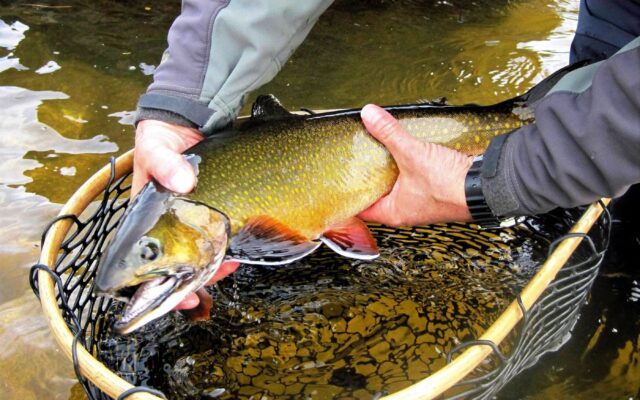
Maine is taking a step backward in protecting our native fish
By Bob Mallard
For the second year in a row, the Maine Department of Inland Fisheries and Wildlife has proposed sweeping rule changes that will liberalize the regulations on most of the waters affected. This includes wild native brook trout waters, State Heritage Fish waters and rare Arctic charr waters.
The impetus of the proposed changes is to improve what DIF&W refers to as “size quality” — to create bigger fish. The idea is harvesting more fish means those left behind will get larger. Specifically, fewer mouths to feed means more food, and more food means bigger fish.

Bangor Daily News Outdoors contributor Bob Mallard caught this large brook trout in the Rapid River.
This flies in the face of science and historical records, ignores other factors that influence growth, and otherwise attempts to oversimplify what is a very complex and highly variable issue.
If harvest is necessary to grow big fish, why do so many historic Maine pictures show stringers of large fish caught at a time when our waters were lightly fished, and by less effective anglers than they are today?
Why do waters such as the Rapid and Magalloway rivers, both catch-and-release waters, grow the largest stream-resident wild brook trout in the state?

Fish demonstrate “indeterminate growth.” They continue to grow throughout their lives, albeit with older fish growing slower than younger fish. When all things are equal, the older the fish, the larger it usually is. If you want big fish, leave them in the water and let them grow.
Proposed as a way to improve “salmonid growth and performance,” DIF&W is replacing what they refer to as “trophy” regulations with “quality” regulations. Six waters are changing from a daily bag limit of one fish with a minimum length of 18 inches to two fish with a minimum length of 6 inches and only one of those fish can be greater than 14 inches.
This represents a loss of 20 percent of the S-18 (one fish, 18-inch minimum) “trophy” waters in the state.
Among 85 wild native salmonid fisheries affected, 75 will have their regulations liberalized. Eighty percent will have the minimum length limit reduced and 8 percent will see both a minimum length reduction and a bag limit increase.
In 35 fisheries, the minimum length limit will be reduced from 12, 14 or 18 inches to 6 inches. This will make it easier for anglers to harvest their limit.
Thirty of 32 State Heritage Fish waters affected by the rule changes will see their regulations liberalized. Of these, 14 have never been stocked and six may or may not have received stocked fish from a tributary source.
We should increase the protection of our State Heritage Fish waters, not decrease it.
Black Pond in Aroostook County is one of only 12 wild native Arctic charr waters in Maine. The daily limit on “brook trout,” which includes charr, will double from one to two fish. The minimum length limit will be reduced from 18 to 6 inches. Like our State Heritage Fish waters, we should be providing more, not less, protection to our rare Arctic charr.
Green Lake in Hancock County is one of only four native landlocked salmon waters in the state. While DIF&W has proposed a slot limit on salmon to improve size quality, they continue to stock nonnative lake trout which compete with salmon for food and space.
As in the past, there is a lack of consistency across regions, showing once again that the regional management model is flawed. Region G, the Fish River Lakes area in Aroostook County, accounts for roughly half the negative changes. Out of 43 wild native salmonid waters that will see changes, 95 percent will see their regulations liberalized. Eighty-one percent will have their minimum length limit reduced and 14 percent will see both a minimum length reduction and bag limit increase.
Most of these changes originated from DIF&W, not from the public. In the case of Currier Ponds in Piscataquis County, public opposition to the proposed changes, much of which came from working guides, was notable and support virtually nonexistent. Unfortunately, DIF&W ignored the input, and at time of this writing, the DIF&W Advisory Council had not challenged it, either.
This proposal is another notable step backward. The constant manipulation of Maine’s fisheries has not served us well. In most cases, it’s where we provide the most protection that we see the largest fish, yet we ignore the data. And shouldn’t wild native fish be managed for natural abundance and age/size?
If you want to experiment, do so on stocked waters.
The trend of liberalizing regulations is not good for the resource, not good for anglers and not good for Maine. Further degradation of our fisheries will cost the state in many ways. We should be looking at providing more protection to our fish, not less.
While you can harvest your way into trouble, and Maine has, you can rarely harvest your way out of trouble.